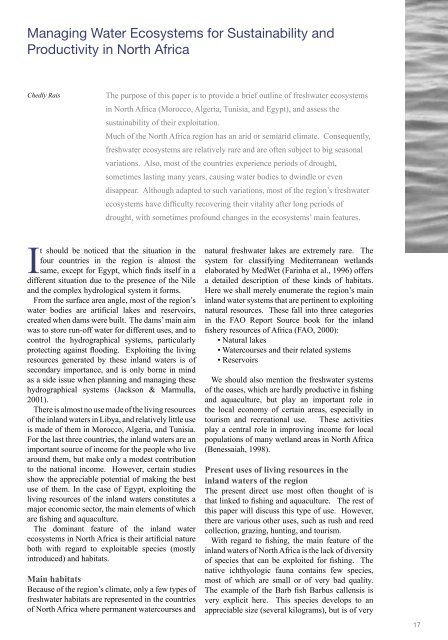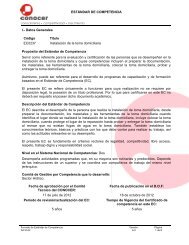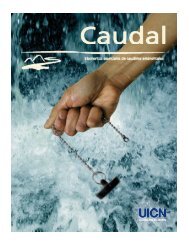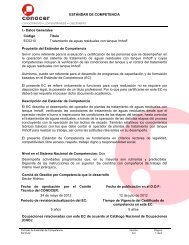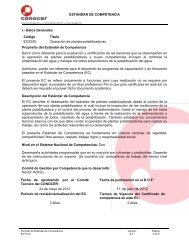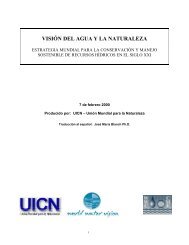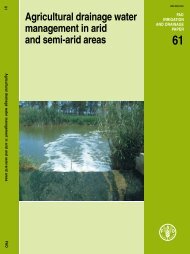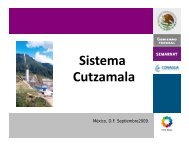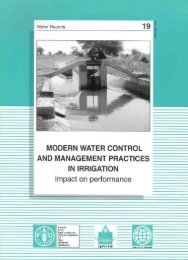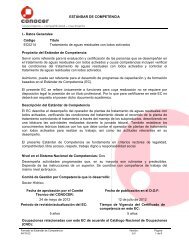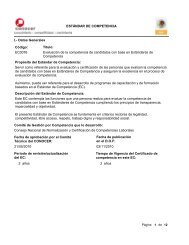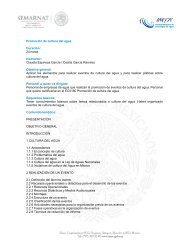The Conservation and Sustainable Use of Freshwater ... - IUCN
The Conservation and Sustainable Use of Freshwater ... - IUCN
The Conservation and Sustainable Use of Freshwater ... - IUCN
Create successful ePaper yourself
Turn your PDF publications into a flip-book with our unique Google optimized e-Paper software.
Managing Water Ecosystems for Sustainability <strong>and</strong><br />
Productivity in North Africa<br />
Chedly Rais<br />
<strong>The</strong> purpose <strong>of</strong> this paper is to provide a brief outline <strong>of</strong> freshwater ecosystems<br />
in North Africa (Morocco, Algeria, Tunisia, <strong>and</strong> Egypt), <strong>and</strong> assess the<br />
sustainability <strong>of</strong> their exploitation.<br />
Much <strong>of</strong> the North Africa region has an arid or semiarid climate. Consequently,<br />
freshwater ecosystems are relatively rare <strong>and</strong> are <strong>of</strong>ten subject to big seasonal<br />
variations. Also, most <strong>of</strong> the countries experience periods <strong>of</strong> drought,<br />
sometimes lasting many years, causing water bodies to dwindle or even<br />
disappear. Although adapted to such variations, most <strong>of</strong> the region’s freshwater<br />
ecosystems have difficulty recovering their vitality after long periods <strong>of</strong><br />
drought, with sometimes pr<strong>of</strong>ound changes in the ecosystems’ main features.<br />
It should be noticed that the situation in the<br />
four countries in the region is almost the<br />
same, except for Egypt, which finds itself in a<br />
different situation due to the presence <strong>of</strong> the Nile<br />
<strong>and</strong> the complex hydrological system it forms.<br />
From the surface area angle, most <strong>of</strong> the region’s<br />
water bodies are artificial lakes <strong>and</strong> reservoirs,<br />
created when dams were built. <strong>The</strong> dams’ main aim<br />
was to store run-<strong>of</strong>f water for different uses, <strong>and</strong> to<br />
control the hydrographical systems, particularly<br />
protecting against flooding. Exploiting the living<br />
resources generated by these inl<strong>and</strong> waters is <strong>of</strong><br />
secondary importance, <strong>and</strong> is only borne in mind<br />
as a side issue when planning <strong>and</strong> managing these<br />
hydrographical systems (Jackson & Marmulla,<br />
2001).<br />
<strong>The</strong>re is almost no use made <strong>of</strong> the living resources<br />
<strong>of</strong> the inl<strong>and</strong> waters in Libya, <strong>and</strong> relatively little use<br />
is made <strong>of</strong> them in Morocco, Algeria, <strong>and</strong> Tunisia.<br />
For the last three countries, the inl<strong>and</strong> waters are an<br />
important source <strong>of</strong> income for the people who live<br />
around them, but make only a modest contribution<br />
to the national income. However, certain studies<br />
show the appreciable potential <strong>of</strong> making the best<br />
use <strong>of</strong> them. In the case <strong>of</strong> Egypt, exploiting the<br />
living resources <strong>of</strong> the inl<strong>and</strong> waters constitutes a<br />
major economic sector, the main elements <strong>of</strong> which<br />
are fishing <strong>and</strong> aquaculture.<br />
<strong>The</strong> dominant feature <strong>of</strong> the inl<strong>and</strong> water<br />
ecosystems in North Africa is their artificial nature<br />
both with regard to exploitable species (mostly<br />
introduced) <strong>and</strong> habitats.<br />
Main habitats<br />
Because <strong>of</strong> the region’s climate, only a few types <strong>of</strong><br />
freshwater habitats are represented in the countries<br />
<strong>of</strong> North Africa where permanent watercourses <strong>and</strong><br />
natural freshwater lakes are extremely rare. <strong>The</strong><br />
system for classifying Mediterranean wetl<strong>and</strong>s<br />
elaborated by MedWet (Farinha et al., 1996) <strong>of</strong>fers<br />
a detailed description <strong>of</strong> these kinds <strong>of</strong> habitats.<br />
Here we shall merely enumerate the region’s main<br />
inl<strong>and</strong> water systems that are pertinent to exploiting<br />
natural resources. <strong>The</strong>se fall into three categories<br />
in the FAO Report Source book for the inl<strong>and</strong><br />
fishery resources <strong>of</strong> Africa (FAO, 2000):<br />
• Natural lakes<br />
• Watercourses <strong>and</strong> their related systems<br />
• Reservoirs<br />
We should also mention the freshwater systems<br />
<strong>of</strong> the oases, which are hardly productive in fishing<br />
<strong>and</strong> aquaculture, but play an important role in<br />
the local economy <strong>of</strong> certain areas, especially in<br />
tourism <strong>and</strong> recreational use. <strong>The</strong>se activities<br />
play a central role in improving income for local<br />
populations <strong>of</strong> many wetl<strong>and</strong> areas in North Africa<br />
(Benessaiah, 1998).<br />
Present uses <strong>of</strong> living resources in the<br />
inl<strong>and</strong> waters <strong>of</strong> the region<br />
<strong>The</strong> present direct use most <strong>of</strong>ten thought <strong>of</strong> is<br />
that linked to fishing <strong>and</strong> aquaculture. <strong>The</strong> rest <strong>of</strong><br />
this paper will discuss this type <strong>of</strong> use. However,<br />
there are various other uses, such as rush <strong>and</strong> reed<br />
collection, grazing, hunting, <strong>and</strong> tourism.<br />
With regard to fishing, the main feature <strong>of</strong> the<br />
inl<strong>and</strong> waters <strong>of</strong> North Africa is the lack <strong>of</strong> diversity<br />
<strong>of</strong> species that can be exploited for fishing. <strong>The</strong><br />
native ichthyologic fauna contains few species,<br />
most <strong>of</strong> which are small or <strong>of</strong> very bad quality.<br />
<strong>The</strong> example <strong>of</strong> the Barb fish Barbus callensis is<br />
very explicit here. This species develops to an<br />
appreciable size (several kilograms), but is <strong>of</strong> very<br />
17


